By Ean McDowell
Australian Ean McDowell is no stranger to the pages of VeloceToday, and one of his most interesting articles is Night Drive in an ASA. Ean knows that while the climate, road conditions, availability of restoration services, events, and the general social environment make Australia an ideal country for car enthusiasts, the opportunity to purchase special cars is not as great as in USA or Europe. That has not stopped him amassing a private collection that includes cars imported from UK, USA, Spain, France, and Mexico. Whether a high revving V12 or a rusty Fiat 1100, Ean has a love for all Italian cars. In this article he describes the amazing history of a Moretti Formula Junior that will be restored and used in events “down under”. Ean has a Stanguellini FJ and compares the Moretti design and innovation to the 1959 championship winning Stanguellini.
“Like you, I bought my most interesting cars unseen, and instantly!!!!” These words came as warm reassurance from Duncan Rabagliati, a very well known motoring historian and Formula Junior expert, in response to the slight apprehension that, without an inspection, I had just bought a 50 year old racing car in need of total restoration.
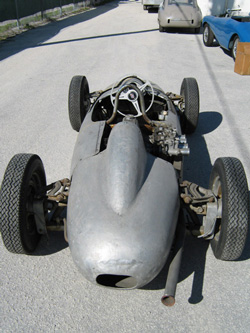
The unrestored 1958 Moretti Branca. This photo convinced the writer that here was a very special little car. An amazing history was about to unfold.
The remarkable chain of events that followed would stretch over four continents in the coming months, and lead to correspondence with many people who had a story to add about this car. Unbelievably it would lead to an exchange of letters with Aquilino Branca who built and raced the car in some 50 years earlier.
The story commenced in a bookshop in Melbourne, Australia. Knowing my interest in Italian Formula Juniors, Fiat 1100s, and a Moretti 750 TdM Spider that I have been slowly restoring, a friend mentioned an old Moretti racing car that “might be for sale”. He wasn’t interested himself so I wasted little time making an international call and without hesitation the purchase was arranged. It would take five months before the car arrived in Australia and I was anxious to use this time to find out more.
Count Lurani’s excellent idea
The concept of Formula Junior was introduced in 1957 as a low cost entry to motor sport, and a training facility for Italian drivers to ensure that country would regain the prominence it held for many years in Grand Prix racing. The first official event was a 12 lap race at Monza on 25th April 1958. The formula would spread to Europe in the second season and to England, U.S.A., and Australia by 1960.
In an effort to contain costs the new formula required the use of 1100cc push rod engines, with gearboxes, suspension, and brakes derived from a production car. The popular Fiat 1100cc 103 Series engine was ideal and with modifications that were permitted to carburetion, exhausts, compression ratio, and valve timing would give a reliable 75 bhp at 6500rpm which was enough in a very light chassis. In fact the Fiat 1100 was so popular that 33 of the 35 cars at Monza in the opening race for the 1959 season were Fiat powered, but that also was about to change. The Fiat 1100 four speed gear box was robust and with closer ratios was ideal at the start, and constructors didn’t have to look beyond the Fiat when it came to brakes either. The mass produced 1100 four seat family sedans had magnificent aluminium drums of huge proportions that were right up to the task.
There were no restrictions on chassis design and initially all but three of the manufacturers chose a conventional front engine layout. Only Wainer, De Sanctis, and the Moretti Branca dared to place the engine behind the driver following the layout of the 500cc Cooper in England and of course the Alfa Romeo and Auto Union Grand Prix cars from the prewar era. It was evident that the rear engine placement was slow to catch on by the second season, when 35 cars lined up for the first race of 1959 at Monza, and still only three were rear engined. There-after the change came quickly and by the start or the 1960 season the front engine cars were completely outclassed, and within a season obsolete.
For the first two years Stanguellini was almost unbeatable. They maintained what must have been the one of the largest race shops in the world at the time but it didn’t stop others from trying. In this environment, and in 1958, Aquilino Branca working from a small workshop in Buscate near Milan, ignored convention and came up with a multi- tube frame with all independent suspension using inboard springing in which he used a rear mounted Fiat 1100 engine driving through an inverted Fiat 600 gearbox.
Branca was no stranger when it came to building and competing in his own cars. He commenced in 1947 and worked through to 1991 when he was forced to shut down for health reasons. Building cars not for commercial or industrial aim but “for my great passion for mechanics” and for “the opportunity to acquire experience and measure myself against the economically great companies” he explained in a number of magazine articles and letters. He met and raced against the best Italian manufacturers of the time, and as a driver he took part in events across Europe.
His cars were successful in the hands of others in Italy and Europe, and as we will see, the feature car was sold in America and won at Sebring, Road America, and other venues in the hands of the great Augie Pabst. In his letters Branca said he was satisfied with the results at the time but the fact that many of the cars he built are still racing must add to his achievements. The opportunity to ask many questions was too great a temptation for an enthusiast to resist and the incredible Mr. Branca responded with many details.
The Origins of the Moretti Branca Formula Junior
In the book “Formula Junior” (Motor Racing Publications 1961), the basic layout of the car was described as somewhat revolutionary and author John Blunsden notes “…. a rear engine potentially offers the car more stability, partly because it calls for a form of independent suspension of the rear wheels. …, and partly because it eases the problem of weight distribution; it also allows the frontal area of the bodywork to be maintained at a minimum.”
Blunsden continued “The latter point was demonstrated convincingly by Aquilino Branca, when he decided to augment the range of Moretti production touring cars from his factory in Buscate, on the outskirts of Milan, with a rear engine Formula Junior single seater. A squat radiator and fuel tank mounted well back against the bulkhead allowed the nose line of the car to be kept unusually low, and by mounting the engine well down in the chassis, so that the sump extended well below the line of the bottom frame members, the head fairing behind the driver was also kept to a modest height. As a result, the Moretti is one of the most squat and compact Italian Junior cars produced to date.”
The cars that followed were pure Branca design and based almost entirely on Fiat. The connection to Moretti was a question I was therefore anxious to discover. Mr. Branca explained “the Moretti Special name was due to an agreement with the Moretti Company whereby I had access to Moretti agents in Italy and abroad. Prior to the single seater cars, in 1952 I had built two new sport 750cc cars called Moretti Specials. They had 70/80mm tubular frames and had been constructed entirely in my shop.”
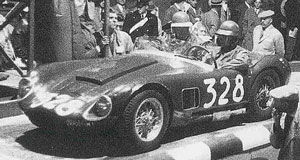
Agostino Gariboldi in the Branca starting the 1957 Mille Miglia. Courtesy La Sport i e suoi artigiani
“I used the Moretti twin camshaft 750cc engine… that produced very good results. One of these cars driven by Gariboldi went on to win the 1957 Italian Mountain championship.”
The Moretti connection ended in 1962 after 11 cars were built in total. It seems three of these were rear engine Formula Juniors of which chassis numbers #006, #020, and the feature car #2.18 all still exist.
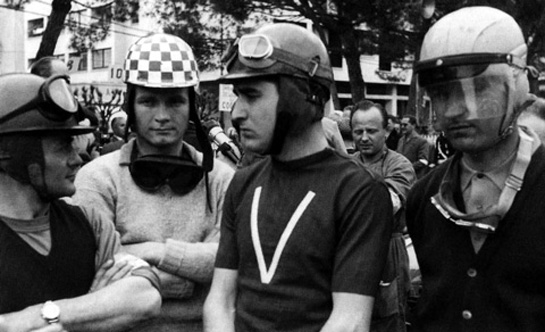
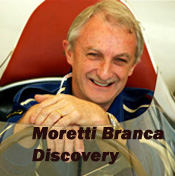
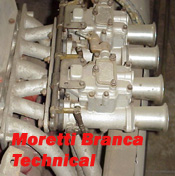
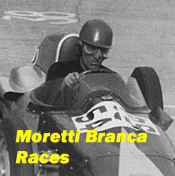
I have 2 photos from the first formula junior race at Monza. These pictures were sent to Altorio and appear in his Taraschi book. I can scan these photos out of the book (Altorio still has the originals) if people wish.
As to the Branca Moretti sportscar that appeared in the 1957 Mille Miglia, I belive the same car appeared in 1956, without the hood scoop.
I also believe that the two cars entered at LeMans in 1956 were really Branca/Morettis and not true Morettis.
Luigi Orsini did a superb book on formula juniors; even better than the 1961 English book, but it is VERY difficult to find.
Best,
Stu
Does anyone have a contact number for Aquilino Branca?